
Atlas F1 Editor in Chief
When young and aspiring writers ask Matt Bishop how they could launch a career in motorsport journalism, the editor in chief of F1 Racing always recommends they start by covering club racing and work their way up. But there are other ways of getting to the top: you can drop out of highschool, clean dairy trucks for a living, sell cheap jewelry, and have an enormous talent and charisma. It certainly worked for Bishop who, as the editor of the biggest selling F1 magazine, has become one of the most powerful and known members of the F1 media. Biranit Goren met Bishop for an interrogation about the famous F1 Racing style, the success of the magazine and the decline of circulation. Exclusive for Atlas F1
The editor in chief of F1 Racing was explaining why he doesn't worry about negative reactions the magazine and its writing style draw - including the excessive use of adjectives such as 'Giga' to describe every other driver in Formula One.
So it took him as long as 34 minutes to use the word that perhaps epitomises the 'F1 Racing style' most; not bad, I tell him. Bishop laughs. "I nearly said 'Mega'," he replies, somewhat abashed, "but we have to move on from 'Mega', you see, because everybody's started copying it."
You can't be a Formula One fan in this day and age and not have read a copy of F1 Racing at one point or another. The magazine, with a circulation of nearly 1 million copies sold worldwide at its peak times - less nowadays - is sold in over 100 countries and in over 20 languages, making it one of Formula One's biggest commercial success.
More importantly, F1 Racing has no other magazine of its kind to challenge it, and not for lack of trying. F1 supremo, Bernie Ecclestone, launched a rival magazine three years ago only to give up last month and leave F1 Racing as a true monopoly in its niche.
The success of F1 Racing is phenomenal every way you look at it. With an average of 300 million people watching every Grand Prix, F1 Racing reaches about one in four of those viewers - giving it a market share unmatched by any other specialised magazine in the world. Much of that success is simply a matter of clever thinking on the part of publishers Haymarket, specialists in motoring publications with a portfolio that includes Autosport, MotorSport, Motorsport News, and more.
But few would deny the biggest factor in making the magazine such a success, is the ever charming and unconventional editor, Matt Bishop. Eight years since the magazine was first launched, and seven years since Bishop assumed his role as its leader, he is by far one of the most influential and one of the most recognised names among the members of the Formula One media.
And the fact that Bishop became such a 'Giga-Star' without any background whatsoever in motor racing or journalism makes his story allthemore compelling.
Matt Bishop's life story sounds more like a Guy Ritchie movie than that of the average Formula One pundit. And certainly, the man who always advises young aspiring writers to start covering club racing for Autosport and work their way up from there to F1 Racing didn't himself come into motor racing journalism in the conventional way. "I wasn't conceived behind the bike-shed in Donington, no," he laughs.
But back in the days when Bishop was born, there wasn't any fame and fortunes around the house, and when the couple separated, Bishop and his younger brother were raised by a single mother in a humble environment. Catholic school was the first stop - "you know, corporal punishment, being caned, all that thing," as Bishop describes it - and teenage Bishop was doing rather well, until the adolescence mutiny kicked in.
"My school thought that I might be a success," he recalls. "But then it all went completely wrong. When I was 16 I just stopped working entirely, and just totally, completely messed up. I did up to my 'O' Levels, did extremely well in that, and then I just stopped working completely. So I did a kind of dropout thing, and from the age of 16 I didn't go to school much and just messed around, had fun. My 'A' Levels were a disaster; and I never went to university."
While his age group went to university, Bishop went to Unigate - the British dairy company giant. "I worked in a factory, doing just a shit job basically," he says. "My job title was 'raw reception
chargehand' and what that meant was that when the big tankers came in I had to screw on a hose, suck out all cream, all the milk out of the tanker - this is all at five in the morning - then climb on top of the truck, lower a rope ladder and with a brush and caustic soda stand in the dark, with steam around you, and clean the inside of the tank.
"It was a ridiculously dangerous job - I'm sure nowadays Unigate have better high-tech ways of doing it - but back then it meant lots of injuries," he laughs.
One "ridiculous job" ensued another. Bishop went on to sell jewelry door to door ("the jewelry was not high quality at all, but I was doing the pitch to penurious housewives"), drive an unlicensed mini cab around London, and finally become a betting shop manager and a bookmaker, taking bets at the now defunct Wembley dog track.
Bishop applied to the university of Kent, and despite having no 'A' Levels was accepted to the social and clinical psychology department. "I managed to persuade them to take me on as a mature student," he smiles. "Like all journalists I'm a bullshitter so I was able to depict my CV as fascinating, and I think I managed to convince them that I was a fascinating person."
But Bishop never finished his university degree; the opportunity that would lead him eventually to F1 Racing came knocking while he was studying his second year, and this time Bishop opened the door.
Journalism is a strange profession. Unlike lawyers, doctors or hair stylists for that matter, there are no formal studies and no license exams required, and even those who make their way into the media following some kind of training are not necessarily destined for greatness. But every journalist has to start somewhere, and in Bishop's case the debut of his journalism career was in racing - Greyhound racing, that is.
He began to write greyhound racing reports while he managed the betting shop at Wembley, submitting his reports to the now defunct ("as almost everything in my life") Sporting Life newspaper as well as the Racing Post ("which still does exist"). Bishop, in his own words, discovered that "this was something I could do; I enjoyed it."
So that's where the journalism part of the deal came from. The Formula One part was more deeply rooted, however.
"I always had a passion for Formula One and for road cars," Bishop explains. "In fact, when I should have been studying for my 'A' Levels I was reading Autosport, and when I should have been studying again I just re-read that issue of Autosport.
Bishop's race reports from Wembley were convincing enough to land him a job at Car magazine - published by Emap, rivals of his current employer Haymarket. He began doing shifts as a subeditor - proof reading other writers' work - but soon enough the part time job became full time and he moved up the ranks fast to become the magazine's features editor and then later the deputy editor. "I was lucky enough to be offered that job and I took it and didn't finish my degree," he concludes. "It's unfortunate in some ways, but this was a job I very much wanted to do."
By 1995, Bishop's name was rising in the British magazine publishing scene, and he was offered the role of deputy editor of Focus, "a kind of popular science magazine, a GQ for trainspotters as I used to categorise it." It was during his time at Focus that Bishop was head-hunted by Haymarket for their then new magazine, F1 Racing.
F1 Racing made its debut in March 1996, at the first Australian Grand Prix to be held in Albert Park, Melbourne. Those were the days of soaring TV ratings for Formula One races, with Jacques Villeneuve making his debut, Damon Hill about to win a World Championship, and Michael Schumacher just starting out at Ferrari. It was the age of commercialism in Formula One - the heyday of sponsorship money and lavish launches.
Haymarket saw a business opportunity up for grabs and tested the water with a low key debut to what would become the leading Formula One magazine in the world and a voice to the Schumacher Generation.
Bishop wasn't around yet when the magazine was launched - Mike Herd, son of MARCH founder Robin Herd - was appointed editor at the tender age of 24, and the likes of future star Tom Clarkson - with no Grand Prix attendance to his name and at the age of 21 - were hired to fill in the 124-page gloss. Articles were seldom longer than 1,200 words and the emphasis was on aesthetic graphic design and quality photo spreads. It was everything the 20-something fans of the sport - rather than the old-fashioned anoraks - were looking for: an up close and personal album of their favourite drivers.
"Once Haymarket realised, after about four issues, that F1 Racing was probably going to succeed, they began to cast around for a full time editor," Bishop recalls. "They wanted someone with experience in such magazines that you tend to luxuriate and an understanding of motor racing. Car magazine was as such, and so I was invited to come to discuss a project which I didn't know what it was about and it turned out to be F1 Racing. So I was lucky enough to be offered the job and I arrived here."
Bishop made his mark in Haymarket fast. He convinced Peter Windsor to join the magazine, after the latter had effectively retired from writing ("As a boy I used to read him when he was writing in Autocar and I think that Peter is the best journalist there has ever been"). He brought veteran journalist Alan Henry, signed on Stephane Samson, and effectively rocket-launched the career of new and returning F1 journalists. By the end of 1998, he was promoted to Group Editor, overseeing the other Haymarket titles, including Autosport. But for the general public - and for himself too, most probably - he remains first and foremost the editor in chief of F1 Racing.
Interviews are never exclusive - they're World Exclusive. Drivers are never superstars - they're Mega Stars (and nowadays Giga Stars). Writers are never just writers - they're part of the story and appear in pictures throughout the magazine. And the editor is never just the Editor. He's The Bish. It's the 'Me' Generation, Formula One style.
It was Bishop who brought the style with him to F1 Racing and he makes no excuses for it; on the contrary, he says it's a conscious choice that has made F1 Racing different and, above all, successful.
"Some people - I think some journalists, possibly even some readers - think that F1 Racing style is a tiny bit self indulgent," Bishop comments. "The fact is that, yes, if I interview someone I'm usually depicted with him, and that applies to the other writers as well. We do that intentionally because, unlike Autosport and its equivalents in other countries, F1 Racing is trying to carve out a slightly different niche, a different role.
"We like the idea of a personality cult. We'd like people who read F1 Racing to think, 'I'm meeting my friends Matt and Peter and Alan and Anthony and Stephane and they're going to tell me what's going on'. That's something I'm unashamed about. The fact that we have profiles is a result of that, which is irritating to some other journalists, I know, but it's been very successful."
For those who come from a more conservative background, where journalists cover the story and not become a part of the story, reading F1 Racing can be a real challenge to the blood pressure. Whether it's Kimi Raikkonen saying in an interview "I'll be right with you Matt" or another writer referring to Bishop as 'The Bish', one cannot escape the feeling that in F1 Racing, Bishop and his colleagues are just as much the celebrities as Michael Schumacher or Juan Pablo Montoya are.
"Look," Bishop reacts, "I don't personally like 'The Bish' but I don't have a problem if some other journalist refers to me as 'The Bish'; it is, after all, only a nickname."
BG: But when you are the story, how can I let you cover the story? And in your case, I could easily say that you are more famous and certainly more influential than probably half the grid. Let's take you and Ralph Firman and do a survey - how many people know Matt Bishop and how many know Ralph Firman? You'd win hands down
BG: Oh come on, you don't get people looking at you, coming out of the paddock, asking for your autograph?
Bishop: "Just occasionally I would get recognised but I'm sure less than Nigel Roebuck, and I know that less than Peter Windsor. Yes, I'm the face of F1 Racing because I'm the editor in chief, but look: in a way our magazine is a little bit like a TV show and the idea of a presenter being visible is totally normal on a TV show. F1 Racing has got a lot more to do with a TV show than with a newspaper, and the idea of commentators or presenters on TV being anything other than highly visible is of course absurd. So I think that's why we do it, and I encourage my staff to do it."
Being a part of the story hasn't always attracted positive reactions, though. A few years ago, when Bishop was just cutting his teeth at his new-found stardom and was consistently critical of then Jaguar driver Eddie Irvine, a website in Northern Ireland retaliated with a special hate mail campaign against Bishop, titled 'Fat Matt Bishop' "because I know I'm not the thinnest man in Christendom," Bishop laughs.
"It's disappeared now, but that was a thing then - it was all about Fat Matt's done this, Fat Matt's done that. And you know, in a way I thought, it's a tiny bit offensive, it's a tiny bit... regrettable. But then on the other hand I thought to myself, if somebody is bothering with themselves to create a Fat Matt Bishop hate website, which is devoted to slating me and F1 Racing, then it must be because at some level we've arrived as a factor on the motorsport map, which is important. And I'm sure there are Jeremy Clarkson hate websites and all I say, you have to welcome these things."
Another example - and one that Bishop himself says is among his favourite features since joining F1 Racing - is the much talked about Mika Hakkinen season preview, where the Finn, for the first time ever, revealed his thoughts on every other driver, including those who were his rivals until not long ago.
"Mika wasn't famous for being much of a quote machine in the past," Bishop says. "Part of that was because he worked for a team which controls the message quite carefully, and Mika understood it and bought into the working culture of McLaren. As a result, some of the journalists thought he was boring, lots of fans thought he was boring, but he wasn't at all boring. He wasn't at all stupid - he was one of the cleverest drivers I've ever met.
"I managed to develop a good working relationship with him over the years, and I stayed a bit in contact with Mika after he retired. I don't claim to be his friend in terms of regular contact in any shape of form - you know, I am only a journalist and he is a World Champion. But when we decided we wanted to do a season preview - and our season preview is always a big issue - we decided we wanted Mika Hakkinen because he hadn't really said very much ever in his career and hasn't said very much since his retirement. We thought people might be interested if he could be persuaded to speak openly at last. And he did."
Bishop's unassuming and friendly approach to the drivers and teams have also seen him host special F1 Racing theme parties for Grand Prix Tours. Along with Peter Windsor, Bishop offers a live, on stage version of what he does in F1 Racing - interviewing drivers and team personnel for a select paying crowd. It's a chance for him to take F1 Racing nearer to the Live TV Show vision he has of the magazine. And to those who've seen him in one of those live nights - entertaining the crowd and exchanging shots with Windsor and the drivers - it would be of little surprise if eventually Bishop does end up with a Formula One television show.
In the eight years since launched, F1 Racing has effectively followed Bernie Ecclestone around and has launched a new localised version in any new market that the F1 supremo conquered.
"But it's a bit like a franchise - like McDonalds - they have to make the Big Mac taste the same even if they change the sauce. The Spanish edition couldn't suddenly do an Alonso article that would look like Autosport, it has to look and be designed to our templates.
"And the success of F1 Racing globally has mirrored the success of Formula One globally. For example, we now have a Middle East version of F1 Racing because Formula One is going to Bahrain. You can buy F1 Racing in Iraq, believe it or not!"
It would be all too easy to dismiss F1 Racing as a fluff magazine, a typical dentist's reception area magazine you flick through while waiting for a root canal. But to their credit, the magazine has maintained a high standard of production and a consistent editorial line - something that F1 Magazine failed to maintain in its final dying year. And on occasion, F1 Racing will hit the bullseye and make the most from the vast access they have to the sport.
Memorable features include Damon Hill interviewing Michael Schumacher - possibly the German's most candid and revealing interview to date; or Darren Heath's photos of the McLaren twin-brake-pedal system - which had McLaren and thereafter every team in the paddock put up blocking screens for fear of more secrets being revealed by clever photographers. And, the magazine has certainly beefed up since its inception: the last issue has 164 pages, with interviews that span over several pages and as much as 8,000 words.
"I think you're wrong," Bishop protests, "because I can point to so many areas where F1 Racing has specifically been critical. For instance, the Michelin tread width affair from last year. If you remember the Monza press conference, the F1 Racing journalists have been absolutely at the forefront of giving Ferrari a hard time, and rightly so.
"Has our relationship with Ferrari suffered as a result? Oh yes, absolutely. Basically our relationship was damaged at that time because we stood up and said what we thought, and from a business point of view - when Vodafone advertises in our magazine - was that wise? No. But it was journalistically correct.
"I'll give you another example: Jaguar has been an advertiser in all Haymarket magazines and continues to be, and yet I should think there's not a team that we've been more critical of - for very good reasons, because they've done such a bad job in their first three years and F1 Racing wrote that. Did Jaguar like it? No. Did they continue to advertise? Yes. And nobody has ever told me in Haymarket to do anything different than that."
BG: Well if anyone has power in that situation it's F1 Racing. If Jaguar won't advertise in your magazine, where are they going to go to? There is no choice for them
Bishop: "Well I think that's a positive point, that F1 Racing and Haymarket are confident enough not to worry about what the advertisers might want them to write."
BG: That's a bit like saying Microsoft was confident enough to tell vendors not to include Netscape on new computers... that is the power of a monopoly
Bishop: "OK, in Formula One we don't really have competition, true, but there's nothing we can do about it, is there?"
Bishop: "Maybe, I don't deny that. But if our magazine isn't perfect, it's not for lack of trying, believe me. We have a very, very serious and rigourous set of monthly meetings, and we go through the content and make sure everything is absolutely and rigourously correct as we think it could be."
Regardless of the efforts put in the magazine, F1 Racing is one of many print magazines that are suffering from a steady decline in circulation in the last few years. Being audited by the Audit Bureau of Circulation, the numbers of F1 Racing are public and available for all to see. And the numbers tell a somewhat gloomy story.
Two years ago, the UK edition of F1 Racing had a worldwide circulation of 100,000 copies a month. One year ago, it sank to 72,000 copies a month. And last month, when their latest audit was released, the circulation has further sank to 63,000 copies - with only 24,000 of these counted as annual subscribers. At this rate, I tease Bishop, Atlas F1 will have passed F1 Racing in a couple of years.
"I think that's down to a number of reasons," Bishop says. "When we launched in 1996, the circulation grew year on year for the first four or five years, very successfully. Then a number of things happened. September 11th 2001 accelerated what was already a bit of a global recession. As Ron Dennis said to me the other day, the world is just simply a less wealthy place now than it was before.
"And then we had the 2002 season which, to purists, was still a great season because some people thought - how wonderful, the sheer excellence of the Ferrari domination: 15 races wins, just two for anyone else. Absolutely stupendous car, the F2002. That's what the purists may have thought, but 2002 was in fact - for all involved in Formula One - a terrible year. It was a terrible year because sporting events do require some sort of drama, and there wasn't that.
"I remember sitting in the press room and watching the Hungarian GP and feeling depressed, and just watching Michael and Rubens drive away from the field at seven or eight tenths of a second per lap, effortlessly, not using all the road... that was bad for the sport. And I think that the continued domination of Michael Schumacher - not so much Ferrari, but Schumacher personally - is bad for the sport.
BG: Still, does the drop in circulation not worry you? How do you fight against such a trend?
Bishop: "Well I'm confident we will see the readership come back; we have survived and our circulation is still healthy, and I would expect it to pick up again. But what we really need is a new Champion. We really do. If Montoya hadn't thrown away the Championship last year - which he did; or if Raikkonen had managed to win it - which he nearly did; if one of those had won the Championship instead of Michael, it would have been mega for all media - websites, magazines and television."
OK, I ask Bishop, could he once and for all please explain where the hell did mega come from?
Bishop laughs heartily. "It's Peter Windsor's word. Peter started Mega. He used the word frequently when he came to the magazine, in 1997. We used to gently chide him and even sometimes call him 'Mega Windsor', and so on. After that, you know how it is between friends and colleagues - a word is bandied around and becomes a little joke word. So 'Mega' began to be used among us. And then he started to write 'Mega' and I noticed that in Formula One circles drivers picked it up.
"'Mega' is a catchy, useful little word and it's pronounceable by everybody. It's a Greek word originally and everybody knows what it means. And I began to hear drivers use it. I remember hearing Jacques Villeneuve say 'Mega' and I remember hearing Giancarlo Fisichella using 'Mega' - instead of 'appy', which is what he normally says. And then I remember hearing three F1 people of different types using the word 'Mega' within the span of a few days: Jacques Villeneuve, Flavio Briatore and Max Mosley. Max, can you imagine? And I thought, how interesting, it's become a Formula One word.
"So one of the things we did was to slightly use it and overuse it intentionally. And then, we decided, for fun, to upgrade to Giga. So if somebody goes up to Giga, we'll have to think of something else."
How do journalists interview each other? The same way porcupines mate: very carefully.
It began as a joke to some extent - at one of those alcohol-saturated paddock events late last year I told Matt Bishop that one day I'll interview him 'F1 Racing Style'. "It will be titled 'World Exclusive with the Mega Bish'," I told him in between hiccups, "and the main photo of the article will show me, wearing sunglasses and looking all serene. You won't even be in it." I have some idea what he must have thought of me back then, but he still returned my calls after that, so that's a start.
And then F1 Magazine shut down, and what began as a joke seemed rather worthy of a feature - a serious one, that would look at the man who, despite his objections to the title, has become so powerful. In other words, a feature Atlas F1 Style.
It is therefore not without feeling guilty that I find myself effectively promoting a rival magazine on Atlas F1. But after more than two hours at Bishop's offices in Teddington, England, and many other conversations over the phone thereafter, I can only say, in all honesty, that Bishop is, for lack of a better word, simply mega.
And one day, you'll see, I'll hire him to write for Atlas F1...
Thirty four minutes into the interview, Matt Bishop said the word Giga.
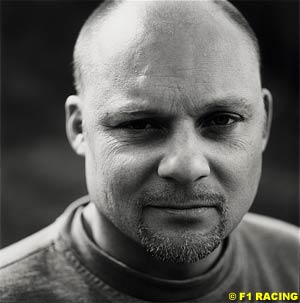 "I think it's inevitable that we'd draw both positive and negative responses," Bishop commented. "[BBC's Top Gear presenter] Jeremy Clarkson is the most successful motoring journalist in the UK - possibly in the world but certainly in the UK. Lots of people love Clarkson; tons of people hate him as well - absolutely hate him. And that's the nature of it. He is a living and breathing Giga-Star."
"I think it's inevitable that we'd draw both positive and negative responses," Bishop commented. "[BBC's Top Gear presenter] Jeremy Clarkson is the most successful motoring journalist in the UK - possibly in the world but certainly in the UK. Lots of people love Clarkson; tons of people hate him as well - absolutely hate him. And that's the nature of it. He is a living and breathing Giga-Star."
Cheap Jewelry and Caustic Soda
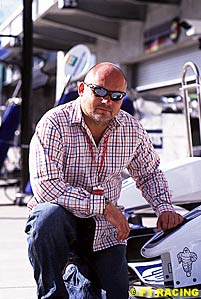 Born Matthew Bishop Kovacevich on December 25th 1962 in London, England, Bishop was the oldest of two sons to a psychoanalyst mother and a musician father. The father, Stephen Kovacevich, is today one of the most famous pianists in the world - one that classical music lovers adore. Frank Williams, for example, was thrilled when Bishop arranged for him to see a concert of his father.
Born Matthew Bishop Kovacevich on December 25th 1962 in London, England, Bishop was the oldest of two sons to a psychoanalyst mother and a musician father. The father, Stephen Kovacevich, is today one of the most famous pianists in the world - one that classical music lovers adore. Frank Williams, for example, was thrilled when Bishop arranged for him to see a concert of his father.
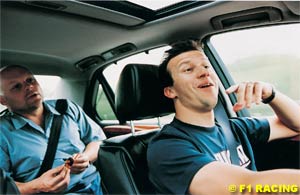 Bishop: "I reached the age of about 26 or something, and I began to think, this is just ridiculous, I know I'm better than this - I could do better than this, I mustn't do this under-achieving, I'll just become a depressed under-achiever. I don't mean that in an elitist way, but I just knew I could become better than this. I knew that I could."
Bishop: "I reached the age of about 26 or something, and I began to think, this is just ridiculous, I know I'm better than this - I could do better than this, I mustn't do this under-achieving, I'll just become a depressed under-achiever. I don't mean that in an elitist way, but I just knew I could become better than this. I knew that I could."
From Greyhound Racing to Motor Racing
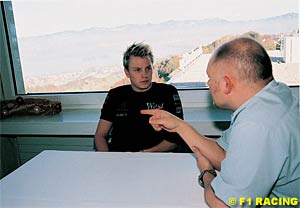 "You know, if somebody asks me today 'who was on pole at Monza in 2003?' I can tell you it was Michael [Schumacher] but I can't tell you the time - I'm not one of those people who can remember stats. But if you asked me, 'who was on pole at Monza in 1977?' - which is when I should have been studying - then I can tell you it was James Hunt, at 1:38.08. Second was Carlos Reuttman, 1:38.15" - a quick check on FORIX shows he's right - "So anything from the late 70s is encyclopedic, autistic. And that's vaguely useful at times."
"You know, if somebody asks me today 'who was on pole at Monza in 2003?' I can tell you it was Michael [Schumacher] but I can't tell you the time - I'm not one of those people who can remember stats. But if you asked me, 'who was on pole at Monza in 1977?' - which is when I should have been studying - then I can tell you it was James Hunt, at 1:38.08. Second was Carlos Reuttman, 1:38.15" - a quick check on FORIX shows he's right - "So anything from the late 70s is encyclopedic, autistic. And that's vaguely useful at times."
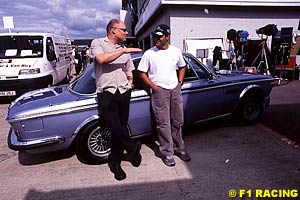 "F1 Racing was launched with a skeleton staff of young, keen, cheap journalists," Bishop explains. "This was a sensible thing to do, because at that time there wasn't a bespoke, proper, coffee-table, serious, high-production-values F1 magazine. So F1 Racing was the first, and it was a risk. And Haymarket didn't want to hire a whole load of people for a project which might not survive - because one never knows."
"F1 Racing was launched with a skeleton staff of young, keen, cheap journalists," Bishop explains. "This was a sensible thing to do, because at that time there wasn't a bespoke, proper, coffee-table, serious, high-production-values F1 magazine. So F1 Racing was the first, and it was a risk. And Haymarket didn't want to hire a whole load of people for a project which might not survive - because one never knows."
To Bish or Not to Bish
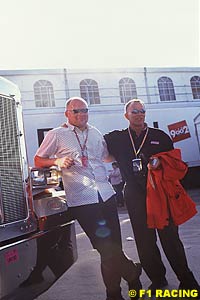 Ask the average fan what he or she thinks of F1 Racing and you'll get a dozen opposing opinions one way or the other. Ask the average fan what he or she recalls of F1 Racing, and the options narrow down. It's the pictures, it's the graphics, and above all it's the style. The 'F1 Racing Style'.
Ask the average fan what he or she thinks of F1 Racing and you'll get a dozen opposing opinions one way or the other. Ask the average fan what he or she recalls of F1 Racing, and the options narrow down. It's the pictures, it's the graphics, and above all it's the style. The 'F1 Racing Style'.
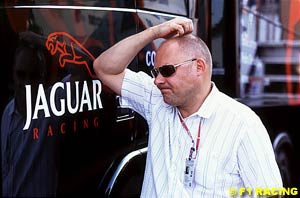 Bishop: "Well I would have to resist, I would have to disagree. I mean, I think... yeah, we don't take ourselves out of the story, I completely agree. But what we're trying to show is that we do have access. That we can bring the drivers to the readers. It must be a successful formula because F1 Racing has been successful. It also makes it different from other magazines and there's a value for being different. Does it irritate? I'm sure it does, and that goes back to Jeremy Clarkson as both successful and the most irritating motoring journalist ever. And you can't be one without the other. You can't. So yes, I'm sure it irritates friends of mine in the paddock. But I must object to what you said - I don't consider myself at all famous. What you're telling me is news to me."
Bishop: "Well I would have to resist, I would have to disagree. I mean, I think... yeah, we don't take ourselves out of the story, I completely agree. But what we're trying to show is that we do have access. That we can bring the drivers to the readers. It must be a successful formula because F1 Racing has been successful. It also makes it different from other magazines and there's a value for being different. Does it irritate? I'm sure it does, and that goes back to Jeremy Clarkson as both successful and the most irritating motoring journalist ever. And you can't be one without the other. You can't. So yes, I'm sure it irritates friends of mine in the paddock. But I must object to what you said - I don't consider myself at all famous. What you're telling me is news to me."
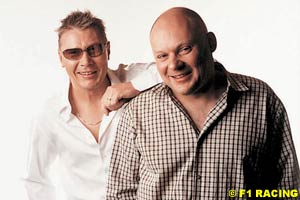 The extent of Bishop's - and F1 Racing's - influence and access in the paddock could be found in the last issue of the magazine: many have tried, for months, to interview McLaren chief Ron Dennis. Only Matt Bishop has succeeded. And to do so, he flew with Dennis to the United States and back - gaining hours of undivided attention that not a single other journalist in the paddock can match.
The extent of Bishop's - and F1 Racing's - influence and access in the paddock could be found in the last issue of the magazine: many have tried, for months, to interview McLaren chief Ron Dennis. Only Matt Bishop has succeeded. And to do so, he flew with Dennis to the United States and back - gaining hours of undivided attention that not a single other journalist in the paddock can match.
The F1 Racing Big Mac
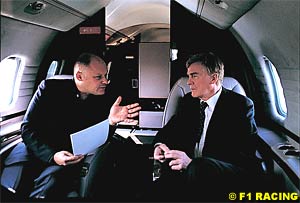 "F1 Racing was launched as a UK magazine but is now sold in more than 100 countries in 24 editions and more than 20 languages," Bishop beams. "The UK one is the 'mother ship' - where the planning is done and really where the articles are all written. But if you looked at the Spanish edition you would see that the articles from the UK edition are translated but every now and then, if it so happens that the UK edition has no Alonso article, then the Spanish would make something local, their own Alonso story.
"F1 Racing was launched as a UK magazine but is now sold in more than 100 countries in 24 editions and more than 20 languages," Bishop beams. "The UK one is the 'mother ship' - where the planning is done and really where the articles are all written. But if you looked at the Spanish edition you would see that the articles from the UK edition are translated but every now and then, if it so happens that the UK edition has no Alonso article, then the Spanish would make something local, their own Alonso story.
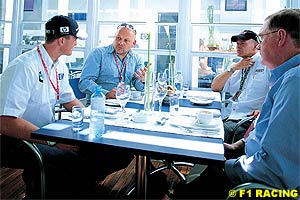 Yet F1 Racing remains a monopoly in its genre, and with F1 Magazine now gone, the power of F1 Racing is not necessarily a healthy one. On the one hand, who would say no to the magazine's requests or demands? And on the other, would a magazine that has no competition and makes its living off the ten teams of the paddock be truly critical of the sport when needed?
Yet F1 Racing remains a monopoly in its genre, and with F1 Magazine now gone, the power of F1 Racing is not necessarily a healthy one. On the one hand, who would say no to the magazine's requests or demands? And on the other, would a magazine that has no competition and makes its living off the ten teams of the paddock be truly critical of the sport when needed?
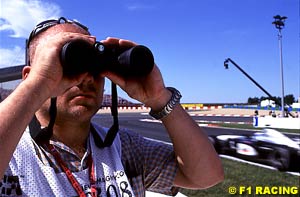 BG: I actually think competition would be good for you. Certainly three years ago, when you suddenly had a potential competitor in F1 Magazine, you raised the bar. It spurred you on whereas maybe you became somewhat complacent before...
BG: I actually think competition would be good for you. Certainly three years ago, when you suddenly had a potential competitor in F1 Magazine, you raised the bar. It spurred you on whereas maybe you became somewhat complacent before...
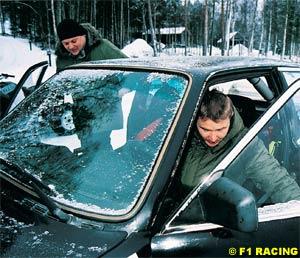 "Michael Schumacher has now won six World Championships, 70 Grands Prix, etc, etc, and I got absolutely nothing against Michael personally - I think Michael is a wonderful Champion, a wonderful ambassador for the sport, probably the best driver ever, you can't take that away from him. But, that continued success turned people off the sport in a way that we still haven't seen a recovery from."
"Michael Schumacher has now won six World Championships, 70 Grands Prix, etc, etc, and I got absolutely nothing against Michael personally - I think Michael is a wonderful Champion, a wonderful ambassador for the sport, probably the best driver ever, you can't take that away from him. But, that continued success turned people off the sport in a way that we still haven't seen a recovery from."
Sidebar: David and Goliath
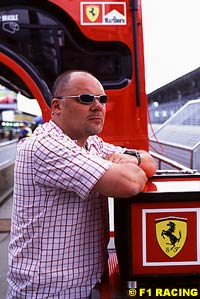 It would be perhaps presumptuous of Atlas F1 to consider itself a rival of F1 Racing, but every Goliath has a David, and both F1 Racing and Atlas F1 compete over the same potential customers. It was therefore not without hesitations and suspicion that this interview took place.
It would be perhaps presumptuous of Atlas F1 to consider itself a rival of F1 Racing, but every Goliath has a David, and both F1 Racing and Atlas F1 compete over the same potential customers. It was therefore not without hesitations and suspicion that this interview took place.
|
Contact the Author Contact the Editor |
Please Contact Us for permission to republish this or any other material from Atlas F1.
|
Volume 10, Issue 9
Atlas F1 Exclusive
The Mega Man
2004 Australian GP Preview
2004 Australian GP Preview
Australian GP Facts & Stats
The F1 Trivia Quiz
Articles
2004 SuperStats: Winter Testing
The Paint Job - Part II
Columns
Rear View Mirror
Bookworm Critique
On the Road
Elsewhere in Racing
The Weekly Grapevine
> Homepage |